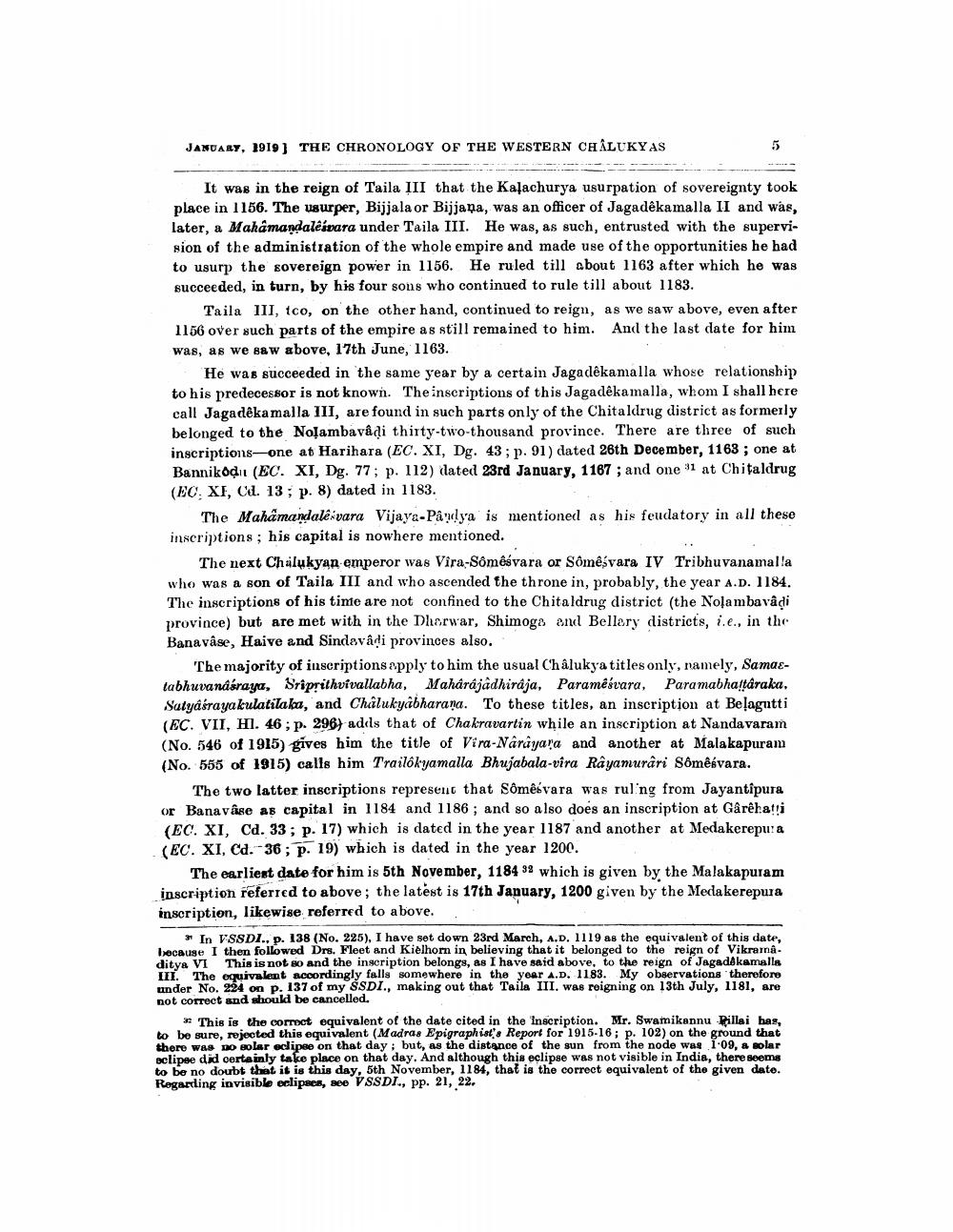Book Title: Indian Antiquary Vol 48 Author(s): Richard Carnac Temple, Devadatta Ramkrishna Bhandarkar Publisher: Swati Publications View full book textPage 9
________________ JANUARY, 1919) THE CHRONOLOGY OF THE WESTERN CHÂLUKYAS It was in the reign of Taila III that the Kalachurya usurpation of sovereignty took place in 1156. The usurper, Bijjala or Bijjana, was an officer of Jagadēkamalla II and was, later, a Mahamandalesvara under Taila III. He was, as such, entrusted with the supervision of the administration of the whole empire and made use of the opportunities he had to usurp the sovereign power in 1156. He ruled till about 1163 after which he was succeeded, in turn, by his four sons who continued to rule till about 1183. Taila III, tco, on the other hand, continued to reign, as we saw above, even after 1156 over such parts of the empire as still remained to him. And the last date for him was, as we saw above, 17th June, 1163. He was succeeded in the same year by a certain Jagadêkamalla whose relationship to his predecessor is not known. The inscriptions of this Jagadêkamalla, whom I shall here call Jagadêka malla III, are found in such parts only of the Chitaldrug district as formerly belonged to the Noļambavadi thirty-two-thousand province. There are three of such inscriptions-one at Harihara (EC. XI, Dg. 43; p. 91) dated 26th December, 1163; one at Bannikodil (EC. XI, Dg. 77; p. 112) dated 23rd January, 1167; and one 31 at Chitaldrug (EC, XF, Col. 13; p. 8) dated in 1183. The Mahamandalê vara Vijaya-Pâulya is mentioned as his feudatory in all these inscriptions ; his capital is nowhere mentioned. The next Chalukyan emperor was Vira-Sômêsvara or Sômêsvara IV Tribhuvanamalla who was a son of Taila III and who ascended the throne in, probably, the year A.D. 1184. The inscriptions of his time are not confined to the Chitaldrug district (the Noļambavadi province) but are met with in the Dharwar, Shimoga and Bellary districts, i.e., in the Banavâse, Haive and Sindavadi provinces also. The majority of inscriptions apply to him the usual Chalukya titles only, namely, Samaelabhuvanásraya, Sriprithvivallabha, Maharajadhiraja, Paramêsvara, Paramabhaltáraka. Satud ravakulatilaka, and Chalukyabharana. To these titles, an inscription at Belagutti (EC. VII. Hl. 46; p. 296) adds that of Chakravartin while an inscription at Nanda varam (No. 546 of 1915) gives him the title of Vira-Narayara and another at Malakapuram (No. 555 of 1915) calls him Trailokyamalla Bhujabala-vira Rayamurâri Sômêsvara. The two latter inscriptions represent that Sômêóvara was ruling from Jayantipura or Bana vâse as capital in 1184 and 1186 ; and so also does an inscription at Gârêhatri (EC. XI, Cd. 33; p. 17) which is dated in the year 1187 and another at Medakerepur a (EC. XI, Cd. -36; p. 19) which is dated in the year 1200. The earliest date for him is 5th November, 1184 33 which is given by the Malakapuram inscription referred to above; the latest is 17th January, 1200 given by the Medakerepura inscription, likewise referred to above. * In VSSDI., p. 138 (No. 225), I have set down 23rd March, A.D. 1119 as the equivalent of this date, because I then followed Drs. Fleet and Kielhom in believing that it belonged to the reign of Vikrama ditya VI This is not so and the inscription belongs, as I have said above, to the reign of Jagad kamalla III. The equivalent accordingly falls somewhere in the year A.D. 1183. My observations therefore under No. 224 on p. 137 of my SSDI., making out that Taila III. was reigning on 13th July, 1181, are not correct and should be cancelled. This is the correct equivalent of the date cited in the Inscription. Mr. Swamikannu Pillai has, to be sure, rejected this equivalent (Madras Epigraphist's Report for 1915-16; p. 102) on the ground that there was no solar eclipse on that day, but, as the distance of the sun from the node was 1.09, a solar eclipse did certainly take place on that day. And although this eclipse was not visible in India, there seems to be no doubt that it is this day, 5th November, 1184, that is the correct equivalent of the given date. Regarding invisible eclipses, see VSSDI., pp. 21, 22.Page Navigation
1 ... 7 8 9 10 11 12 13 14 15 16 17 18 19 20 21 22 23 24 25 26 27 28 29 30 31 32 33 34 35 36 37 38 39 40 41 42 43 44 45 46 47 48 49 50 51 52 53 54 55 56 57 58 59 60 61 62 63 64 65 66 67 68 69 70 71 72 73 74 75 76 77 78 79 80 81 82 83 84 85 86 87 88 89 90 91 92 ... 458
